|
|
The links are to corresponding pages at Amazon.com
for convenient purchase. Some of these books are out of print, but Amazon.com has used copies of many of them for sale.
You may also be able to find used copies at
half.com.
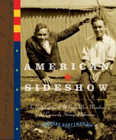
|
American Sideshow:
An Encyclopedia of History's Most Wondrous and Curiously Strange Performers
by Marc Hartzman
Marc Hartzman has undertaken an ambitious project: a chronicle of those showfolks who performed in American sideshows from circa 1830
to the present. Starting with the golden era under P.T. Barnum, Hartzman gives the reader brief biographical introductions to these unusual performers.
Hartzman's prose offers a good humored look at the place where truth and hype converge. The text is accompanied by rare
photographs from the author's and other collections (including that of yours truly). The short, the tall, the fat, the tattooed, the conjoined, the hirsute,
the limbless: they're all here to discover inside Hartzman's tent.
|


|
James Taylor's Shocked and Amazed!
On & Off the Midway
by James Taylor and Kathleen Kotcher
Finally, those who have been outbid on eBay
while trying to acquire the long out-of-print early issues of
James Taylor's magazine devoted to all things sideshow can read
many of the fascinating articles collected in this book, which
acts as a sort of Shocked and Amazed greatest hits
collection. Over 250 pages of memories, history and humbug straight
from the carnies' mouths are compiled in one handy volume, generously
illustrated with photographs.
One can only hope this will be the first in
a series of volumes collecting articles from the fabulous magazine. |


|
The Dr. Ikkaku Ochi Collection:
Medical Photographs from Japan Around 1900
edited by Akimitsu Naruyama
This collection of photographs is remarkable for several reasons: 1) the photos document the
final stages of horrendous diseases (many of which are rarely seen these days); 2) the images
are portraits of real individuals in great pain, but presented with stoic dignity; 3) it
provides an insight into the remarkable level of surgical skill at work in Meiji-era Japan; and
4) the very survival of these photographs at all is something of a miracle when you consider
they were sitting near ground zero when the American atom bomb exploded over Hiroshima.
Truly, this is not a volume for the squeamish. In these pages one finds a startling array of
diseases, from smallpox to the bacterial infections that ravished faces and limbs. Tumors,
conjoined twins and leprosy each receive equal billing, and with often startling clarity. Also
here are the before-and-after shots where one sees how Japanese surgeons excised tumors or
reconstructed a missing nose, which is especially poignant when one considers the very
rudimentary level of sterility and anesthesia available at the time.
One can't help but be moved by these documents of human suffering and triumph, and then thank
one's lucky stars that they live in an era of modern antibiotics.
|

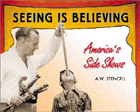
|
Seeing Is Believing: America's Side Shows
by A. W. Stencell
The author of Girl Show (see review below) has provided a sequel to that loving tribute to bump and grind
shows. This volume covers the variety of sideshow entertainments to be found on North American midways from
the nineteenth century to the present day. Motordromes, miniature mechanical villages, racing
monkeys — all that and more are discussed in minute detail. |

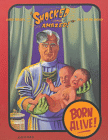
|
James Taylor's Shocked and Amazed!
On & Off the Midway
edited by James Taylor and Kathleen Kotcher
Published not nearly as often as its hordes of rabid fans would like, this journal is the
premier source for information about sideshow and showfolks. Each issue features interviews
and articles about sideshow performers, promoters and history — straight from the midway to
your mitts. The most recent issue, Volume 9, was released in November 2007 — and features a ton of illustrations by yours truly. Buy a copy today, and get one for a friend!
See ShockedandAmazed.com
for more information.
|


|
Wild, Weird, and Wonderful:
The American Circus Circa 1910 as seen by F. W. Glasier
by Mark Sloan
Professional portrait photographer Fred Whitman Glasier maintained a studio in Brockton, Massachusetts.
Glasier never traveled with a circus, but he did document every show that came through his neck of the woods
during the first quarter of the twentieth century. Glasier became acquainted with many famous
showmen, and provided promotional photographs for both the circuses and individual performers. Glasier's
work evokes a relaxed elegance missing from the work of many previous photographers, and for that reason he is now
considered among the finest circus photographers of all time.
Glasier's original glass plate negatives have been beautifully reprinted in this volume,
allowing one to see the scope of his circus work, and occasionally gain an insight into his
working methods when notes and cropping marks have been preserved. As a document of the
traveling circus at a particular point in time, this book is unrivaled.
Circus historian Timothy Tegge provides a brief foreword discussing the origins of the
American circus. Author Mark Sloan provides background information on the people and places
depicted in Glasier's beautiful photographs. |

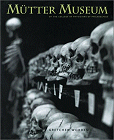
|
The Mütter Museum
by Gretchen Worden
I have long been a fan and frequent visitor
to
the Mütter Museum, and the items in its collection have served
and continue to serve as inspiration for my work. The late Gretchen Worden (1947 - 2004) was most
generous in allowing me access to some of the 'behind the scenes' items I am delighted
to find included in this book. Anyone who has come across one of the famous
Mütter Museum calendars will be familiar with the beautiful photographs from the likes
of Rosamond Wolff Purcell, Joel-Peter Witkin, Max Aquilera-Hellweg, etc. — and if not,
this is the ideal opportunity to experience them. However, for me it is the archival
photos from the bowels (ahem!) of the Mütter's storage rooms that are the real treasures
here - many of which have never been published before. In spite of their generally more
clinical nature, these photographs of patients and odd medical conditions often achieve
a level of artistry equal to the efforts of the featured contemporary photographers.
The images are complemented by an engaging preface and essay by Ms. Worden, which discuss
not only the reasons why artists are drawn to the Mütter's collections,
but also how these 'pathological treasures' came together under the roof of the College of Physicians. |


|
The Last Sideshow
by Hanspeter Schneider, with an essay by Peter Schardt
What happens when a German fashion photographer stumbles into Gibsonton, Florida? Interesting photographic portraits of showfolks at home in their natural surroundings result — perhaps more a portrait of Gibsonton itself.
Little Pete Terhurne (on the cover), Ward Hall, Jeanie the Half-girl, and a host of other residents of 'Showtown, USA' stood before Schneider's camera. |

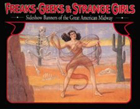
|
Freaks, Geeks and Strange Girls:
Sideshow Banners of the Great American Midway
by Randy Johnson, Jim Secreto and Teddy Varndell, with contributions from others
Freaks, Geeks and Strange Girls is an overview of the gaudy advertising nurtured and developed on American fair grounds
to convince patrons to spend their hard earned nicker on the often dubious attractions inside
the tent. Banner painting developed its own vernacular and traditions over the years, and the
material presented here runs the gamut from the naive to the highly sophisticated. The illustrations
are accompanied by essays on various aspects of sideshow culture, but what I find the most interesting
are the firsthand accounts provided by banner painter and performer Johnny Meah.
[Note: My copy of this book is from the original 1996 Hardy Marks pressing, but the title was reprinted in 2005 by a
different publisher. I haven't seen the new version yet, so I'm not sure whether the content has been updated from the original.]
|

Step Right This way:
The Photographs of Edward J. Kelty
by Miles Barth and Alan Siegel, with an essay by Edward Hoagland
Shortly after end of the 1st World War, Edward Kelty opened his Century Flashlight Photographers studio in midtown Manhattan. Working with large format cameras, Kelty specialized in
photographing large groups at banquets and other such gatherings. In the summer of 1921, shortly after the
subway was extended to Coney Island, Kelty began to frequent the shows and photograph the performers of the
seaside resort. He became fascinated by the world of the circus and sideshow and began to travel with several
companies, shooting documentary and promotional photographs of the performers along the way.
His photographs — sometimes featuring thousands of individuals in a single shot —
are invaluable and iconographic documents of the golden age of the traveling shows. The
photographs are wonderful relics of this lost period of American popular entertainment.
Where this book falls short is in the accompanying text, which does little to further enlighten
the reader. Captions are minimal, often just repeating the information that Kelty himself
inscribed on the negative; but the point of the book is the photographs, which often speak for themselves. |

The Munchkins of Oz
by Stephen Cox
In November of 1938, Metro-Goldwyn-Mayer Studios gathered together approximately 130 little
people from all over the United States to act as Munchkins in a production of The Wizard of Oz.
For many of the little actors — some of whom were pros in traveling midget reviews, and some of
whom had never been away from home before — this was just another job, at best a few weeks of
pleasant diversion from their usual routines. No one knew at the time that they would be part of one of
history's best loved motion pictures, an icon of popular culture. Most of the little
actors were not even listed in the film's credits, and few even knew their names.
Stephen Cox pays homage to these little people, and reconstructs what went on during and after the filming
of The Wizard of Oz, finally giving these performers their due recognition. More than
thirty surviving Munchkins provided interviews and shared their personal stories with the author.
The text is complemented by numerous photographs of the Munchkins during the film's production and
in their later years. |


|
Lord Minimus:
The Extraordinary Life of Britain's Smallest
Man
by Nick Page
Jeffrey Hudson, born into a butcher's family in 1619, was elevated — through
introduction by the Duke of Buckingham — to court dwarf of Charles I's queen, Henrietta Maria.
In service of his queen, Hudson undertook several missions to the continent on her behalf.
He was appointed a captain of horse during the English civil wars, and had his portrait painted
by several artists, including no less a luminary than Anthony Van Dyke. As if that wasn't enough,
Jeffrey was captured by pirates — on two separate occasions. Following the latter incident,
he was sold into slavery to the Turks, but afterwards ransomed and allowed to return to England —
where he was unfortunately and erroneously implicated in a faux plot against Charles II and spent some time in prison before
being vindicated.
That's quite a lot to happen to anyone, let alone someone only about three feet tall.
Hudson's life, the stuff of legends, is here recounted and reconstructed from a surprisingly
sparse historical record. Though the author does his best to narrate and detail a compelling
story, he frequently falls prey to hyperbolic exaggeration, repetition, tedious foreshadowing,
and speculation; but, for all that, this is still a fascinating and accessible insight into
one of the most unusual characters in English history. |


|
Monsters:
Human Freaks in America's Gilded Age
by Michael Mitchell
Devoted to the work of Victorian-era Bowery photographer Charles Eisenmann,
this book is a reprinting of an edition published under a different title in the 1970's.
Having never seen the earlier edition I can't compare the two,
but this one (put out by ECW Press) contains a number of essays about Eisenmann's working methods,
Victorian photographic conventions, etc., and 87 plates accompanied by biographies of the performers
depicted, except in the case of several unknown individuals.
I applaud Mr. Mitchell and ECW Press for reviving this project, but I wish the book were better
researched and included a wider range of Eisenmann's work. The photographs
are quite nicely reproduced and exceptionally clear. But I wonder why — out of a collection
numbering 500 images — some of these photos merited inclusion and others did not. The author
includes multiple images of some performers when a single example would have sufficed. Sometimes
less is more, and deleting the extraneous shots would have allowed for inclusion of more
interesting subjects.
I guess we'll have to wait for someone else to publish a definitive catalogue of Chas. Eisenmann's freak
portraits. In the meantime, this book is very much worth owning, despite my reservations. |


|
In the Little World:
A True Story of Dwarfs, Love, and Trouble
by John H. Richardson
This book grew out of a magazine article Richardson
published in Esquire after attending a Little People of America
(LPA) convention in 1997. That article caused an uproar in the
dwarf community, many of whom accused the author of unfairly exploiting
them and presenting little people and LPA in an unflattering and
sensationalized manner. Over the course of two years, the author
became more personally involved in the lives of several dwarfs, and
found himself wrapped up in an entire spectrum of intense human emotion
experienced through the narrow filter of 'the little world'. The
author attempts to come to terms with his own feelings of otherness
and examines his own and others' conceptions of beauty. The resulting
narrative is very honest, often funny, and engaging. |

Hoaxes, Humbugs and Spectacles:
Astonishing Photographs of Smelt Wrestlers,
Human Projectiles, Giant Hailstones, Contortionists, Elephant
Impersonators, and Much, Much More
by Mark Sloan
It's a weird, weird world out there and we're lucky that people have often thought to capture some
of this nuttiness on film. Here Mark Sloan presents circus performers, unusual stunts, and photographic documents of
wacky phenomena of all sorts. In short, a little of something for everyone — including a
monumental portrait of Woodrow Wilson composed of 21,000 soldiers on an Ohio army base in 1919. |


|
Weird and Wonderful:
The Dime Museum in America
by Andrea Stulman Dennett
Weird and Wonderful is a comprehensive look at
the distinctly American popular entertainment institutions that evolved
from 'cabinets of curiosities' and flourished as presenters of
diverse democratic amusements in the late Victorian era. |

In Search of the Monkey Girl
by Randall Levenson and Spaulding Gray
The author's photographs and notes provide a
behind-the-scenes look at carny life in this out of print and
difficult to find classic. Levenson's formal portraits of sideshow
performers and carnival institutions are augmented by Gray's "Stories
From the 1981 Tennessee State Fair", in which he relates his experiences
tagging along to the fair over the course of eight days - during
which Levenson tried in vain to get Percilla "The Monkey Girl" Bejano
to sit for a portrait. |


|
Side Show:
My Life with Geeks, Freaks & Vagabonds
in the Carny Trade
by Howard Bone with Daniel Waldron, editor,
with a foreword by Teller
Howard Bone saw it and did it all, and entertainingly
cuts up many a jackpot in this memoir of his long career. All
he ever wanted to be was a mediocre sideshow magician, but in the
course of forty years Bone succeeded in becoming a carny jack-of-all-trades
— canvasman, ticket seller, talker, magician, "Mr. Judo," "The Man
Who Can't Be Hung," and who knows what else.
Side Show is a great read that ends too soon. |

Mr. Wilson's Cabinet of Wonder:
Pronged Ants, Horned Humans, Mice on Toast,
and Other Marvels of Jurassic Technology
by Lawrence Weschler
Operating out of a storefront in Los Angeles,
David Hildebrand Wilson's Museum of Jurassic Technology presents
exhibitions of truly wonderful objects — objects so wonderful
that visitors are left to marvel and ponder over which exhibits
are in fact real. This provocative look at Wilson's museum won
a Pulitzer Prize for general non-fiction. |

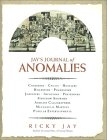
|
Jay's Journal of Anomalies:
Conjurers, Cheats, Hustlers, Hoaxsters, Pranksters,
Jokesters, Imposters, Pretenders, Side-Show Showmen, Armless
Calligraphers, Mechanical Marvels, Popular Entertainments
by Ricky Jay
The author of Learned Pigs & Fireproof
Women has here collected and amended with editorial
corrections all sixteen issues of his late quarterly journal devoted
to all aspects of unusual performance. Each issue of Jay's Journal
focuses on some peculiar and often obscure subject — such as the conjurer's
art of nose amputation, the methods of training fleas, or how seventeenth
century gentlemen cheated at bowling. Each article is thoroughly researched
and beautifully illustrated with rare engravings and photographs from
Jay's private collection. This volume is a treat for those of us unable
to acquire the original issues that were printed in small letterpress
editions. |

The Two
by Irving & Amy Wallace
This is a well-researched and well-written biography
(biographies?) of the original Siamese Twins, Chang & Eng.
The rise of Chang & Eng from Thai peasants to internationally
famous phenomenon is traced through personal letters, newspaper accounts,
and family memoirs. All of this is presented in a lively and engaging
manner, making for a surprisingly good read. |


|
Millie-Christine:
Fearfully and Wonderfully Made
by Joanne Martell
A perfect companion to The Two, Martell's
book documents the life of Millie-Christine, the United African
Twins. Contemporaries of Chang & Eng (and fellow North Carolinians),
Millie-Christine were born into slavery. Stolen from one master,
the girls began their show business career at an early age. Through
a curious mixture of intrigue, education, and ballyhoo, Millie-Christine
became an international sensation as the Two-Headed Nightingale.
The former slaves eventually retired as wealthy and respected citizens,
owning a portion of the plantation on which they were born. Martell's
book relies heavily on letters and other contemporary sources to
present a portrait of conjoined sisters who turned extremely adverse
situations to their favor. |

Freaks:
We Who Are Not As Others
by Daniel Mannix
Freaks is in category unto itself. While one can't
always trust the accuracy of Mannix's statements, the value of this
book could stand on the variety and quality of its photographs alone,
all of which were culled from Mannix's personal collection. Quite simply,
this book is a page-turner. I guarantee that if you bring out this
book among a gathering of friends, there will be constant gasps and
giggles as the book is passed from hand to hand. I received this book
as a gift from my wife, and I refer to it so often I've inadvertently
broken its spine. Many of these photos and stories have served as
inspiration for my drawings. |

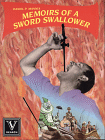
|
Memoirs of Sword Swallower
by Daniel Mannix
Daniel Mannix was a kid from Philadelphia's
Main Line who literally ran away from home to join the circus.
Working on a traveling show during the 1940's, Mannix learned to
perform a number of sideshow acts, including fire-eating and
sword swallowing. Although Mannix's prose often leaves much to
be desired, Memoirs opens with this memorable passage:
"I probably never would have become America's leading fire-eater
if Flamo the Great hadn't happened to explode that night in front
of Krinko's Great Combined Carnival Side Shows."
Memoirs is an interesting window into carny
life, detailing many of the traditional midway scams and the dangers
of performance and endless string of drunken townies looking for a
fight. |

History and Lore of Freaks
by C. J. Thompson
This rather dated little book is still a good
reference, covering the role of freaks in society from ancient
Babylon to the Edwardian era. The text is well illustrated with
photographs and engravings. |


|
Learned Pigs and Fireproof Women
— Unique, Eccentric and Amazing Entertainers:
Stone Eaters, Mind Readers, Poison Resisters, Daredevils, Singing
Mice, etc., etc., etc., etc.
by Ricky Jay
From the title you can tell that this book concentrates
on a wide array of bizarre entertainments from acrobatic horses
to armless violinist/marksmen. The informative and amusing text
is lavishly illustrated with antique engravings, circus advertisements,
and photographs. Of particular interest is the final chapter on
Joseph Pujol, Le Pétomane, who thrilled late 19th century French
audiences with the acoustic facility of his rectum. So overcome with
mirth were Pujol's audiences that "many fainted and fell down and had
to be resuscitated." |

Very Special People:
The Struggles, Loves, and Triumphs of Human
Oddities
by Frederick Drimmer
Drimmer's book is a classic of the genre. A
bit sentimental, Drimmer nevertheless treats his subjects respectfully.
Biographical entries are broken into categories such as "Armless
and Legless Wonders," "The Hairy People," "Chained for Life,"
etc. An interesting series of photographs illustrates the text. |

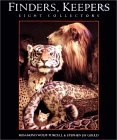
|
Finders, Keepers:
Eight Collectors
by Rosamond Wolff Purcell and Stephen Jay Gould
Purcell and Gould once again collaborated
on a book that combines Purcell's exquisite photographs with the
well-known naturalist's prose. Of particular interest is the chapter
devoted to the remnants of Peter the Great's collection in Leningrad
— which in the true tradition of wunderkammern contains such
curious items as a two-headed sheep, a four-legged rooster, "teeth
extracted by Emperor Peter from various persons," and some eerily
beautiful anatomical specimens prepared by 18th century Dutch master
Frederick Ruysch. |

Special Cases:
Natural Anomalies and Historical Monsters
by Rosamond Purcell
This book came three years after an exhibition
of the same title curated by Purcell at the Getty Research Institute.
A book beautifully bound and copiously illustrated with the author's photographs,
Special Cases is a feast for the eyes. |


|
Freakery:
Cultural Spectacles of the Extraordinary Body
edited by Rosemarie Garland Thomson
Freak Show:
Presenting Human Oddities for Amusement and
Profit
by Robert Bogdan
Freaks:
Myths and Images of the Secret Self
by Leslie Fieldler
All three of these books approach the concept
of "freak" from a sociological and cultural point of view. Thomson's
collection of essays at times seems overly concerned with upholding
ideas of political correctness to the point of patronizing a "disabled,
exploited minority." Fielder's book covers much of the same ground
but includes a wider scope of historical context, which adds weight
to his arguments without becoming too preachy. Bogdan's book is
probably the most balanced of the set, weighing history against perception. |

The World's Most Fantastic Freaks
by Mike Palmer
Palmer's book is wider in scope than Lobster
Boy but just about as tacky. Short passages about past
and present human oddities are interspersed with little known
"facts" that often have little or nothing to do with the surrounding
text. I suppose this book belongs to the same genre as Robert Ripley's
cartoons or those 18th century biographical collections of eccentrics. |


|
A Cabinet of Medical Curiosities
by Jan Bondeson
Featuring the collected essays of the noted medical
historian, the text is occasionally rather dry, but this book
is chocked full of interesting information and illustrations from
the author's collection or unusual sources. Of the author's three
books reviewed here, Cabinet is the most complete in
scope and unity of presentation. |

The Elephant Man:
A Study in Human Dignity
by Ashley Montagu
Montagu's book is a rather thorough biography
of Joseph Merrick, popularly known as the Elephant Man. However,
Montagu makes a rather curious choice in that the main thrust of
the book is to promote the idea of motherly love as ultimate gift and
virtue. That aspect of the book is a bit saccharin, but shouldn't detract
from the biography's overall merits. |


My Very Unusual Friends
by Ward Hall
Written in a whirlwind stream-of-consciousness style, Ward Hall's book is a rare treat — a
glimpse into the world of the traveling sideshow by one of America's greatest showmen, who spent over
fifty years in the business — most notably with his World of Wonders show. Hall's book details
over forty years of his memories and experiences of working with and employing sideshow freaks.
Ward Hall hired and/or befriended many sideshow legends, including Schlitzie the Pinhead.
Hall tells their stories in an honest and personal conversational manner. It's the next best thing to
talking to the man himself.
|


|
Lobster Boy:
The Bizarre Life and Brutal Death of Grady Stiles,
Jr.
by Fred Rosen
Written for the sort of folks who read supermarket
tabloids, Rosen's book is pure giddying exploitative crap. Despite
its unrelenting awfulness, this book is the only text I know of that fully
covers the 1992 murder of longtime sideshow attraction Grady Stiles,
Jr. (a.k.a., Lobster Boy). The crime scene and autopsy photographs
are not for the faint of heart. |

Articulating the Elephant Man:
Joseph Merrick and His Interpreters
by Peter W. Graham and Fritz H. Oehlschlaeger
This book discusses the presentation and occasional
reconstruction of Merrick from the Victorian era through David
Lynch's film. Even Montagu's book is scrutinized. The greatest
detraction from Graham & Oehlschlaeger's text is that there
is not a single illustration of Merrick or anything else in the entire
book. As I'm sure you've noticed, I'm a great believer in the value
of pictures.
|

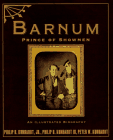
|
P. T. Barnum:
America's Greatest Showman
by Philip B. Kunhardt, Philip B. Kunhardt III,
and Peter W. Kunhardt
This beautifully illustrated biography of the
great showman documents every aspect of Barnum's stellar career.
More than any other single person, Barnum changed the character
of popular entertainment. The collection of photographs that
dominate the text is wonderfully reproduced. |

The Unfashionable Human Body
by Bernard Rudofsky
While not specifically about human oddities
or sideshow performance, this book focuses on historical ideas
of beauty at various times and in various cultures. Forms of body
modification from foot-binding and head-shaping to the perils of modern
fashion apparel are discussed. Rudofsky details the ways humans seek
to deform themselves or mimic deformity to approach an ideal of beauty.
|

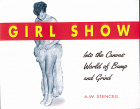
|
Girl Show:
Into the Canvas World of Bump and Grind
by A. W. Stencell
This lavishly illustrated text covers the history
of another staple midway attraction, the all-girl dance revue.
From 19th century hoochie-coochie dancers to modern strippers,
the whole fun and sleazy spectrum of carnival burlesque is represented. |

A Morning's Work:
Medical Photographs from the Burns Archive & Collection 1843-1939
edited by Stanley M. Burns, M.D.
A beautiful book, although I should warn that
it does contain some rather shocking and grotesque photos. Dr.
Burns explains each image with a brief text.
|

Anomalies and Curiosities of Medicine
by George M. Gould, M.D. and Walter L. Pyle, M.D.
Originally published in 1896, this book still
holds its own rather well. The work's subtitle describes it
best: "Being an encyclopedic collection of rare and extraordinary
cases, and of the most striking instances of abnormality in all branches
of medicine and surgery, derived from an exhaustive research
of medical literature from its origin to the present day, abstracted,
classified, annotated, and indexed." This work is now in the public
domain, and there are many pressings available. If you purchase a
copy, make sure that it includes the 308 illustrations that accompanied
the original.
|

return to missionCREEP.com
All Images and Text © James G. Mundie 2003 - 2018
|
|

